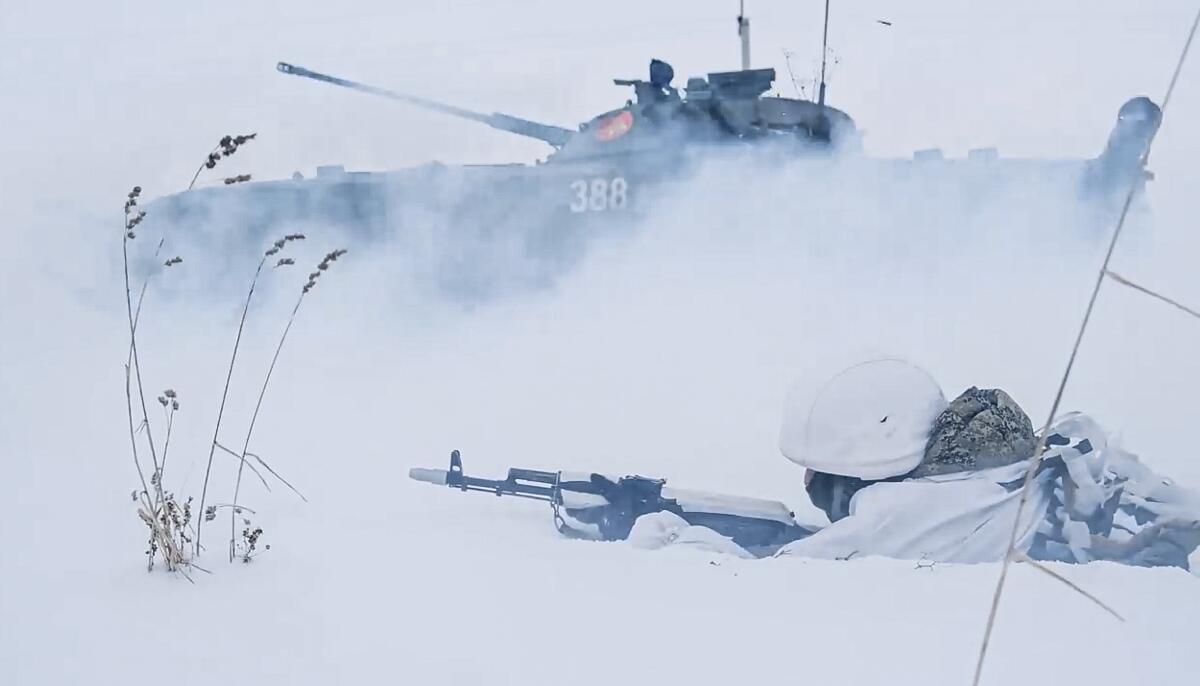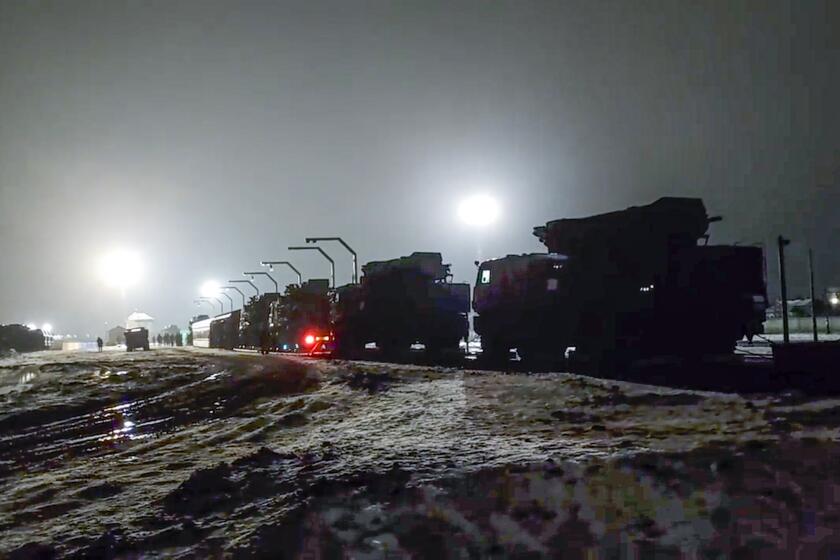U.S. says new intelligence shows Russia plotting a ‘false flag’ attack

- Share via
BRUSSELS — The U.S. accused the Kremlin on Thursday of an elaborate plot to fabricate an attack by Ukrainian forces that Russia could use as a pretext to take military action against its neighbor.
Pentagon spokesman John Kirby said the scheme included production of a graphic propaganda video that would show staged explosions and use actors depicting mourners.
The plan for the fake attack on Russian territory or Russian-speaking people was revealed in declassified intelligence shared with Ukrainian officials and European allies in recent days. It is the latest allegation by the U.S. and Britain that Russia is plotting to use a false pretext to go to war against Ukraine.
The White House in December accused Russia of developing a “false-flag” operation to create pretext for an invasion. Britain recently named specific Ukrainians it accused of having ties to Russian intelligence officers plotting to overthrow Ukrainian President Volodymyr Zelensky. The U.S. also released a map of Russian military positions and detailed how officials believe Russia will try to attack Ukraine with as many as 175,000 troops.
“We’ve seen these kinds of activity by the Russians in the past, and we believe it’s important when we see it like this, and we can, to call it out,” Kirby told reporters at the Pentagon.
The U.S. has not provided detailed information backing up the intelligence findings.
Kirby said that the Russians would also stage military equipment used by Ukraine and the West to bolster the credibility of the scheme.
The new U.S. intelligence found that Russia would possibly use Turkish-made Bayraktar drones as part of the fake operation, according to a senior administration official who was not authorized to comment and spoke on condition of anonymity.
The drones supplied by NATO member Turkey have been used by Ukraine against pro-Russia separatists in the Donbas region, a move that angered Moscow, which has made clear it is strongly opposed to Ukraine being equipped with the technology.
The U.S. unveiled the intelligence as Turkish President Recep Tayyip Erdogan offered to mediate talks between Russia and Ukraine and NATO warned that Moscow’s military buildup continues, with more troops and military equipment deployed to neighboring Belarus than at any time in the last 30 years.
A Russian lawmaker is encouraging residents of the rebel-controlled areas of Ukraine who hold Russian passports to join the Russian army.
Erdogan, who has close but sometimes difficult ties with Russian President Vladimir Putin, said Thursday that Turkey was “prepared to undertake its part in order to end the crisis between two friendly nations that are its neighbors in the Black Sea.”
“I have stressed that we would be happy to host a summit meeting at a leadership level or technical level talks,” Erdogan said after about three hours of talks with Zelensky. “Instead of fueling the fire, we act with the logical aim of reducing the tensions.”
Russia has amassed more than 100,000 troops near Ukraine’s northern and eastern borders, raising concern that Moscow might invade again, as it did in 2014. The troop presence and uncertainty have unnerved Ukrainians and hurt the country’s economy. Russian officials deny that an invasion is planned.
Erdogan underlined Turkey’s commitment to Ukraine’s territorial integrity and sovereignty. Turkey and Ukraine also signed eight agreements during the meeting, including a free trade pact, according to Turkey’s state-run Anadolu Agency.
Zelensky welcomed Erdogan’s offer and thanked him for his “firm and consistent” support.
The crisis has put Turkey in a fix, leaving it in a position where it has to balance its growing partnership with Ukraine with its difficult relations with Moscow.
Kurt Groszhans is accused of attempting to kill a former business partner who is now a Ukrainian government minister.
The government in Ankara, which has historic ties to Ukraine and ethnic bonds with its Crimean Tatar community, strongly opposed Russia’s 2014 annexation of Crimea.
At the same time, Turkey would be reluctant to join in any sanctions against Russia. With a struggling economy, the country has pinned its hopes on tourism revenue, especially from Russian visitors. It also relies on Russia for much of its natural gas needs.
At NATO headquarters earlier, Secretary-General Jens Stoltenberg warned that Russian troop numbers in Belarus are likely to climb to 30,000, with the backing of special forces, advanced fighter jets, Iskander short-range ballistic missiles and S-400 ground-to-air missile defense systems.
“Over the last days, we have seen a significant movement of Russian military forces into Belarus. This is the biggest Russian deployment there since the Cold War,” Stoltenberg told reporters.
Russian Defense Minister Sergei Shoigu was in Minsk, the Belarusian capital, on Thursday, checking on preparations for major Russia-Belarus war games scheduled for Feb. 10-20. Shoigu met with Belarusian President Alexander Lukashenko. Speaking about the drills, Lukashenko said the goal was “to reinforce the border with Ukraine.”
At the same time, Ukrainian Defense Minister Oleksii Reznikov sought again to project calm, saying the probability of an invasion was “low,” and he welcomed a change by U.S. officials, who have stopped using the term “imminent” when describing the risk of a Russian attack.
Reznikov said “the threat exists, the risks exist, but they have existed since 2014, ever since Russia has become an aggressor.” He said “there are no grounds for panic, fear, flight or the packing of bags.” The minister put the number of Russian troops near Ukraine at 115,000.
Ukrainian civilian volunteers know they couldn’t stop an invading Russian army. But they could slow things down — and exact a price.
Still, Stoltenberg renewed his call for Russia to “de-escalate,” and repeated warnings from the West that “any further Russian aggression would have severe consequences and carry a heavy price.”
The North Atlantic Treaty Organization has no intention of deploying troops to Ukraine should Russia invade, but it has begun to reinforce the defenses of nearby member countries — notably Estonia, Latvia, Lithuania and Poland. The 30-nation military alliance also plans to beef up its defenses in the Black Sea region near Bulgaria and Romania.
Stoltenberg also embraced President Biden’s decision Wednesday to send 2,000 U.S.-based troops to Poland and Germany and to shift 1,000 more from Germany to Romania, demonstrating to both allies and foes Washington’s commitment to NATO’s eastern flank.
Breaking News
Get breaking news, investigations, analysis and more signature journalism from the Los Angeles Times in your inbox.
You may occasionally receive promotional content from the Los Angeles Times.
“We are committed to finding a political solution to the crisis, but we have to be prepared for the worst,” Stoltenberg said, and he appreciated other recent offers of troops and equipment from several allies. Russia objects to the troop move and has described it as “destructive.”
In Helsinki, Finnish leaders held talks with European Commission President Ursula von der Leyen about a letter that Russian Foreign Minister Sergei Lavrov sent to several countries on the “indivisibility of security” in Europe.
Lavrov argues that the U.S. and NATO misunderstand the concept — which essentially means that the security of one European country is linked to the security of them all — and he has demanded replies from countries that signed a key security document encompassing it to clarify the issue.
Finnish Prime Minister Sanna Marin said that there was no “big news” in the letter but that it warranted a reply. Von der Leyen said the commission, the European Union’s executive branch, will coordinate a response, even though Lavrov insisted that only countries and not organizations should answer.
More to Read
Sign up for Essential California
The most important California stories and recommendations in your inbox every morning.
You may occasionally receive promotional content from the Los Angeles Times.
















